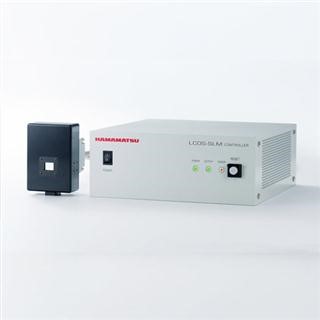滨松空间光调制器LCOS-SLM算法方案:如何自由摆布光束分布
本网页为滨松绝对量子产率分析仪Quantaurus-QY在实际使用中的FAQ。
|
在讲座视频中,滨松中国工程师分享了基于空间光调制器(LCOS-SLM)在具体应用情境下的算法方案,涵盖并行加工算法、光束整形算法、SLM的反馈算法、SLM的二次开发与方案提供。新手用户将收获如何将应用与算法精准匹配,体验事半功倍的实验开局;老用户将收获如何进一步优化SLM使用效果,开辟SLM玩法进阶新世界。讲座内容分为以下具体部分:
00:00:56 SLM算法使用简介
00:04:25 并行加工算法
00:18:13 光束整形算法
00:36:44 SLM的反馈算法
00:48:39 SLM的二次开发与方案提供
00:49:33 Q&A
|
|

|
|
|
|
 The generation of flat-top beams by complex amplitude modulation with a phase-only spatial light modulator The generation of flat-top beams by complex amplitude modulation with a phase-only spatial light modulator
|
|
 Holographic projection of arbitrary light patterns with asuppressed zero-order beam Holographic projection of arbitrary light patterns with asuppressed zero-order beam
|
|
 Dynamic laser beam shaping for material processing using hybridholograms Dynamic laser beam shaping for material processing using hybridholograms
|
|
 Single-pulse writing of a concave microlens array Elimination of a zero-order beam inducedby a pixelated spatial light modulatorfor holographic projection Single-pulse writing of a concave microlens array Elimination of a zero-order beam inducedby a pixelated spatial light modulatorfor holographic projection
|
|
 Ultra long high resolution beam by multi-zone rotationally symmetrical complex pupil filter Ultra long high resolution beam by multi-zone rotationally symmetrical complex pupil filter
|
|
 Dynamic three-dimensional multifocal spots in high numerical-aperture objectives Dynamic three-dimensional multifocal spots in high numerical-aperture objectives
|
|
 Axial multifocal spots generated by sectored phase-only modulation under tight focusing condition Axial multifocal spots generated by sectored phase-only modulation under tight focusing condition
|
|
 A high-accuracy algorithm for designingarbitrary holographic atom traps A high-accuracy algorithm for designingarbitrary holographic atom traps
|
|
 Iterative Fourier-transform algorithm applied to computerholography Iterative Fourier-transform algorithm applied to computerholography
|
|
 Surface nanoprocessing with nondiffractingfemtosecond Bessel beams Surface nanoprocessing with nondiffractingfemtosecond Bessel beams
|
|
 Computer generation of optimalholograms for optical trap arrays Computer generation of optimalholograms for optical trap arrays
|
|
 Iterative algorithms for holographicshaping of non-diffracting andself-imaging light beams Iterative algorithms for holographicshaping of non-diffracting andself-imaging light beams
|
|
 Reduction of two-photon holographic speckle using shift-averaging Reduction of two-photon holographic speckle using shift-averaging
|

|
针对以上内容,如您有任何问题,欢迎联系我们
|
|

|